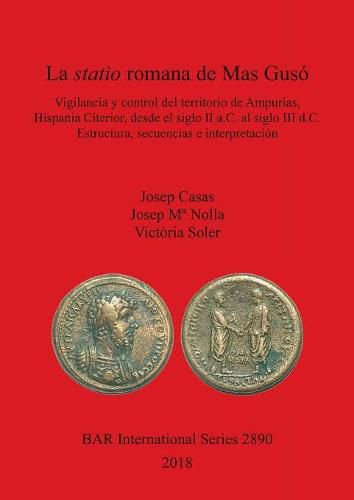Readings Newsletter
Become a Readings Member to make your shopping experience even easier.
Sign in or sign up for free!
You’re not far away from qualifying for FREE standard shipping within Australia
You’ve qualified for FREE standard shipping within Australia
The cart is loading…






This title is printed to order. This book may have been self-published. If so, we cannot guarantee the quality of the content. In the main most books will have gone through the editing process however some may not. We therefore suggest that you be aware of this before ordering this book. If in doubt check either the author or publisher’s details as we are unable to accept any returns unless they are faulty. Please contact us if you have any questions.
The present volume on the site of Mas Guso presents in detail the results obtained during fourteen excavation campaigns, focusing, this time, on the Roman settlement. This complex was built in the late second century BC over an old Iberian settlement, which in turn occupied the space on which an Early Iron Age community had previously settled, following a previous Bronze Age settlement. The Roman complex of Mas Guso had a military-public function, as a praesidium intended to control the hinterland territories of Emporion and to take part in military actions within the province of Hispania Citerior, beginning with the Late Republic, c. 135 BC, and continuing for several centuries until its disappearance around 280 AD. During the first decades of the Common Era, the complex was probably transformed into a statio, directly linked to the local road network, although it did not lose its military function. The building presents a classical structure, showing a clear Italic influence that is observed repeatedly and with little variation throughout the Empire.
En el presente volumen sobre Mas Guso se exponen extensamente los resultados obtenidos a lo largo de catorce campanas de excavaciones, referidos, en esta ocasion, al establecimiento de epoca romana. Un complejo levantado hacia finales del siglo II a.C. sobre un antiguo asentamiento iberico, el cual, a su vez, ocupo el mismo espacio en el que anteriormente se establecio una comunidad de la primera Edad del Hierro, sucesora de otra de la Edad del Bronce. El conjunto romano de Mas Guso tuvo un caracter publico-militar, un praesidium relacionado con el control del hinterland ampuritano y con las operaciones militares en la Hispania Citerior, desde la Baja Republica, hacia el 135 a.C., prolongandose su existencia a lo largo de los siglos, hasta desaparecer alrededor del ano 280. A partir de las primeras decadas de nuestra era, probablemente fue transformado en una statio, vinculada directamente a la red viaria local, sin perder su funcion militar. Adopta una estructura clasica, de clara filiacion italica, que se repite con pocas variaciones a lo largo de todo el Imperio.
$9.00 standard shipping within Australia
FREE standard shipping within Australia for orders over $100.00
Express & International shipping calculated at checkout
This title is printed to order. This book may have been self-published. If so, we cannot guarantee the quality of the content. In the main most books will have gone through the editing process however some may not. We therefore suggest that you be aware of this before ordering this book. If in doubt check either the author or publisher’s details as we are unable to accept any returns unless they are faulty. Please contact us if you have any questions.
The present volume on the site of Mas Guso presents in detail the results obtained during fourteen excavation campaigns, focusing, this time, on the Roman settlement. This complex was built in the late second century BC over an old Iberian settlement, which in turn occupied the space on which an Early Iron Age community had previously settled, following a previous Bronze Age settlement. The Roman complex of Mas Guso had a military-public function, as a praesidium intended to control the hinterland territories of Emporion and to take part in military actions within the province of Hispania Citerior, beginning with the Late Republic, c. 135 BC, and continuing for several centuries until its disappearance around 280 AD. During the first decades of the Common Era, the complex was probably transformed into a statio, directly linked to the local road network, although it did not lose its military function. The building presents a classical structure, showing a clear Italic influence that is observed repeatedly and with little variation throughout the Empire.
En el presente volumen sobre Mas Guso se exponen extensamente los resultados obtenidos a lo largo de catorce campanas de excavaciones, referidos, en esta ocasion, al establecimiento de epoca romana. Un complejo levantado hacia finales del siglo II a.C. sobre un antiguo asentamiento iberico, el cual, a su vez, ocupo el mismo espacio en el que anteriormente se establecio una comunidad de la primera Edad del Hierro, sucesora de otra de la Edad del Bronce. El conjunto romano de Mas Guso tuvo un caracter publico-militar, un praesidium relacionado con el control del hinterland ampuritano y con las operaciones militares en la Hispania Citerior, desde la Baja Republica, hacia el 135 a.C., prolongandose su existencia a lo largo de los siglos, hasta desaparecer alrededor del ano 280. A partir de las primeras decadas de nuestra era, probablemente fue transformado en una statio, vinculada directamente a la red viaria local, sin perder su funcion militar. Adopta una estructura clasica, de clara filiacion italica, que se repite con pocas variaciones a lo largo de todo el Imperio.